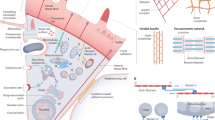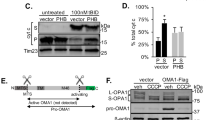Abstract
Physiological oxidants that are generated by activated phagocytes comprise the main source of oxidative stress during inflammation1,2. Oxidants such as taurine chloramine (TnCl) and hydrogen peroxide (H2O2) can damage proteins and induce apoptosis, but the role of specific protein oxidation in this process has not been defined. We found that the actin-binding protein cofilin is a key target of oxidation. When oxidation of this single regulatory protein is prevented, oxidant-induced apoptosis is inhibited. Oxidation of cofilin causes it to lose its affinity for actin and to translocate to the mitochondria, where it induces swelling and cytochrome c release by mediating opening of the permeability transition pore (PTP). This occurs independently of Bax activation and requires both oxidation of cofilin Cys residues and dephosphorylation at Ser 3. Knockdown of endogenous cofilin using targeted siRNA inhibits oxidant-induced apoptosis, which is restored by re-expression of wild-type cofilin but not by cofilin containing Cys to Ala mutations. Exposure of cofilin to TnCl results in intramolecular disulphide bonding and oxidation of Met residues to Met sulphoxide, but only Cys oxidation causes cofilin to induce mitochondrial damage.
This is a preview of subscription content, access via your institution
Access options
Subscribe to this journal
Receive 12 print issues and online access
$209.00 per year
only $17.42 per issue
Buy this article
- Purchase on Springer Link
- Instant access to full article PDF
Prices may be subject to local taxes which are calculated during checkout





Similar content being viewed by others
Change history
15 October 2009
In the version of this letter initially published, the following sentence and reference were ommited: However, a recent study has also reported that cofilin oxidation impairs its cytoskeletal function in T cells28. 28. Klemke, M, Wabnitz, G. H., Funke, F., Funk, B., Kirchgessner, H. & Samstag, Y. Oxidation of cofilin mediates T cell hyporesponsiveness under oxidative stress conditions. Immunity 29, 404-413 (2008). This error has been corrected in the HTML and PDF versions of the letter.
References
Babior, B. M. Phagocytes and oxidative stress. Am. J. Med. 109, 33–44 (2000).
Weiss, S. J., Klein, R., Slivka, A. & Wei, M. Chlorination of taurine by human neutrophils. Evidence for hypochlorous acid generation. J. Clin. Invest. 70, 598–607 (1982).
Rhee, S. G. et al. Intracellular messenger function of hydrogen peroxide and its regulation by peroxiredoxins. Curr. Opin. Cell Biol. 17, 183–189 (2005).
Giles, G. I. The redox regulation of thiol dependent signaling pathways in cancer. Curr. Pharm. Des 12, 4427–4443 (2006).
Englert, R. P. & Shacter, E. Distinct modes of cell death induced by different reactive oxygen species: amino acyl chloramines mediate hypochlorous acid-induced apoptosis. J. Biol. Chem. 277, 20518–20526 (2002).
Klamt, F. & Shacter, E. Taurine chloramine, an oxidant derived from neutrophils, induces apoptosis in human B lymphoma cells through mitochondrial damage. J. Biol. Chem. 280, 21346–21352 (2005).
Stadtman, E. R. & Levine, R. L. Free radical-mediated oxidation of free amino acids and amino acid residues in proteins. Amino Acids 25, 207–218 (2003).
Prutz, W. A. Hypochlorous acid interactions with thiols, nucleotides, DNA, and other biological substrates. Arch. Biochem. Biophys. 332, 110–120 (1996).
Winterbourn, C. C. & Kettle, A. J. Biomarkers of myeloperoxidase-derived hypochlorous acid. Free Radic Biol. Med. 29, 403–409 (2000).
Shacter, E. Quantification and significance of protein oxidation in biological samples. Drug Metabol. Rev. 32, 307–326 (2000).
Pattison, D. I. & Davies, M. J. Absolute rate constants for the reaction of hypochlorous acid with protein side chains and peptide bonds. Chem. Res. Toxicol. 14, 1453–1464 (2001).
Peskin, A. V. & Winterbourn, C. C. Kinetics of the reactions of hypochlorous acid and amino acid chloramines with thiols, methionine, and ascorbate. Free Radic Biol. Med. 30, 572–579 (2001).
Newmeyer, D. D. & Ferguson-Miller, S. Mitochondria: releasing power for life and unleashing the machineries of death. Cell 112, 481–490 (2003).
Green, D. R. & Kroemer, G. The pathophysiology of mitochondrial cell death. Science 305, 626–629 (2004).
Wu, Y., Kwon, K. S. & Rhee, S. G. Probing cellular protein targets of H2O2 with fluorescein-conjugated iodoacetamide and antibodies to fluorescein. FEBS Lett. 440, 111–115 (1998).
Baty, J. W., Hampton, M. B. & Winterbourn, C. C. Proteomic detection of hydrogen peroxide-sensitive thiol proteins in Jurkat cells. Biochem. J. 389, 785–795 (2005).
Bamburg, J. R. & Wiggan, O. P. ADF/cofilin and actin dynamics in disease. Trends Cell Biol. 12, 598–605 (2002).
Chua, B. T. et al. Mitochondrial translocation of cofilin is an early step in apoptosis induction. Nature Cell Biol. 5, 1083–1089 (2003).
Zhu, B., Fukada, K., Zhu, H. & Kyprianou, N. Prohibitin and cofilin are intracellular effectors of transforming growth factor β signaling in human prostate cancer cells. Cancer Res. 66, 8640–8647 (2006).
Mannherz, H. G. et al. Activated cofilin colocalises with Arp2/3 complex in apoptotic blebs during programmed cell death. Eur. J. Cell Biol. 84, 503–515 (2005).
Kinnally, K. W. & Antonsson, B. A tale of two mitochondrial channels, MAC and PTP, in apoptosis. Apoptosis 12, 857–868 (2007).
Chipuk, J. E. & Green, D. R. How do BCL-2 proteins induce mitochondrial outer membrane permeabilization? Trends Cell Biol. 18, 157–164 (2008).
Sharpe, J. C., Arnoult, D. & Youle, R. J. Control of mitochondrial permeability by Bcl-2 family members. Biochim. Biophys. Acta 1644, 107–113 (2004).
Wei, M. C. et al. Proapoptotic BAX and BAK: a requisite gateway to mitochondrial dysfunction and death. Science 292, 727–730 (2001).
Kowaltowski, A. J., Castilho, R. F. & Vercesi, A. E. Mitochondrial permeability transition and oxidative stress. FEBS Lett. 495, 12–15 (2001).
Lee, Y. J. & Shacter, E. Oxidative stress inhibits apoptosis in human lymphoma cells. J. Biol. Chem. 274, 19792–19798 (1999).
Poole, L. B., Karplus, P. A. & Claiborne, A. Protein sulfenic acids in redox signaling. Annu. Rev. Pharmacol. Toxicol. 44, 325–347 (2004).
Klemke, M., Wabnitz, G. H., Funke, F., Funk, B., Kirchgessner, H. & Samstag, Y. Oxidation of cofilin mediates T cell hyporesponsiveness under oxidative stress conditions. Immunity 29, 404–413 (2008).
Nakajima, H. et al. The active site cysteine of the proapoptotic protein glyceraldehyde-3-phosphate dehydrogenase is essential in oxidative stress-induced aggregation and cell death. J. Biol. Chem. 282, 26562–26574 (2007).
Nadeau, P. J., Charette, S. J., Toledano, M. B. & Landry, J. Disulfide Bond-mediated multimerization of Ask1 and its reduction by thioredoxin-1 regulate H2O2-induced c-Jun NH(2)-terminal kinase activation and apoptosis. Mol. Biol. Cell 18, 3903–3913 (2007).
Hengartner, M. O. The biochemistry of apoptosis. Nature 407, 770–776 (2000).
Shacter, E., Williams, J. A., Hinson, R. M., Senturker, S. & Lee, Y. J. Oxidative stress interferes with cancer chemotherapy: inhibition of lymphoma cell apoptosis and phagocytosis. Blood 96, 307–313 (2000).
Kim, J. R., Yoon, H. W., Kwon, K. S., Lee, S. R. & Rhee, S. G. Identification of proteins containing cysteine residues that are sensitive to oxidation by hydrogen peroxide at neutral pH. Anal. Biochem. 283, 214–221 (2000).
Kang, D. K. et al. Iron regulatory protein 2 as iron sensor. Iron-dependent oxidative modification of cysteine. J. Biol. Chem. 278, 14857–14864 (2003).
Levine, R. L. Fixation of nitrogen in an electrospray mass spectrometer. Rapid Commun. Mass Spectrom. 20, 1828–1830 (2006).
Senturker, S., Tschirret-Guth, R., Morrow, J., Levine, R. & Shacter, E. Induction of apoptosis by chemotherapeutic drugs without generation of reactive oxygen species. Arch. Biochem. Biophys. 397, 262–272 (2002).
Klamt, F., Roberto de Oliveira, M. & Moreira, J. C. Retinol induces permeability transition and cytochrome c release from rat liver mitochondria. Biochim. Biophys. Acta 1726, 14–20 (2005).
Petronilli, V., Cola, C., Massari, S., Colonna, R. & Bernardi, P. Physiological effectors modify voltage sensing by the cyclosporin A-sensitive permeability transition pore of mitochondria. J. Biol. Chem. 268, 21939–21945 (1993).
Acknowledgements
We thank the members of the Laboratory of Biochemistry for critical comments and discussions, and R. Youle and P. Clerc for providing Bax/Bak knockout cells and an anti-Bax N terminus antibody. The research was supported in part by the Brazilian MCT/CNPq Universal funds (479860/2006-8). F.K. and S.Z. were supported by training grants from the Oak Ridge Institute for Science and Education. This project was funded in part by federal funds from the National Cancer Institute, National Institutes of Health, under Contract NO1-CO-12400. The content of this publication does not necessarily reflect the views or policies of the Department of Health and Human Services, nor does mention of trade names, commercial products, or organizations imply endorsement by the United States Government. The authors would like to dedicate this manuscript to the memory of Earl R. Stadtman for his mentoring and pioneering work in biochemistry and protein oxidation.
Author information
Authors and Affiliations
Contributions
F.K., S.Z., R.L.L. and E.S. carried out project planning, experimental design, experimental work and data analysis. F.K. carried out experiments for Figs 1, 2, 4, 5, S1 and S2, and helped write the manuscript. S.Z. carried out experiments for Figs 3, 4, 5 and S3, S4, S5, S6, S7, and helped write the manuscript. R.L.L. carried out experiments for Figs S6 and S7. A.P. carried out experiments and data analysis for Fig. S4. Y.Z. and B.Z. carried out experiments for Fig. 3. L.-R.Y. and T.D.V. carried out experiments and data analysis for Fig. S1. E.S. carried out experiments for Fig. 4, directed the research and wrote the manuscript.
Corresponding author
Ethics declarations
Competing interests
The authors declare no competing financial interests.
Supplementary information
Supplementary Information
Supplementary Information (PDF 2180 kb)
Rights and permissions
About this article
Cite this article
Klamt, F., Zdanov, S., Levine, R. et al. Oxidant-induced apoptosis is mediated by oxidation of the actin-regulatory protein cofilin. Nat Cell Biol 11, 1241–1246 (2009). https://doi.org/10.1038/ncb1968
Received:
Accepted:
Published:
Issue Date:
DOI: https://doi.org/10.1038/ncb1968
This article is cited by
-
Effect of dietary Bifidobacterium animalis subsp. lactis BLa80 on growth, immune response, antioxidant capacity, and intestinal microbiota of juvenile Japanese seabass (Lateolabrax japonicus)
Aquaculture International (2024)
-
The multiple links between actin and mitochondria
Nature Reviews Molecular Cell Biology (2023)
-
Cepharanthine sensitizes human triple negative breast cancer cells to chemotherapeutic agent epirubicin via inducing cofilin oxidation-mediated mitochondrial fission and apoptosis
Acta Pharmacologica Sinica (2022)
-
GDAP1 loss of function inhibits the mitochondrial pyruvate dehydrogenase complex by altering the actin cytoskeleton
Communications Biology (2022)
-
Cofilin1 oxidation links oxidative distress to mitochondrial demise and neuronal cell death
Cell Death & Disease (2021)



